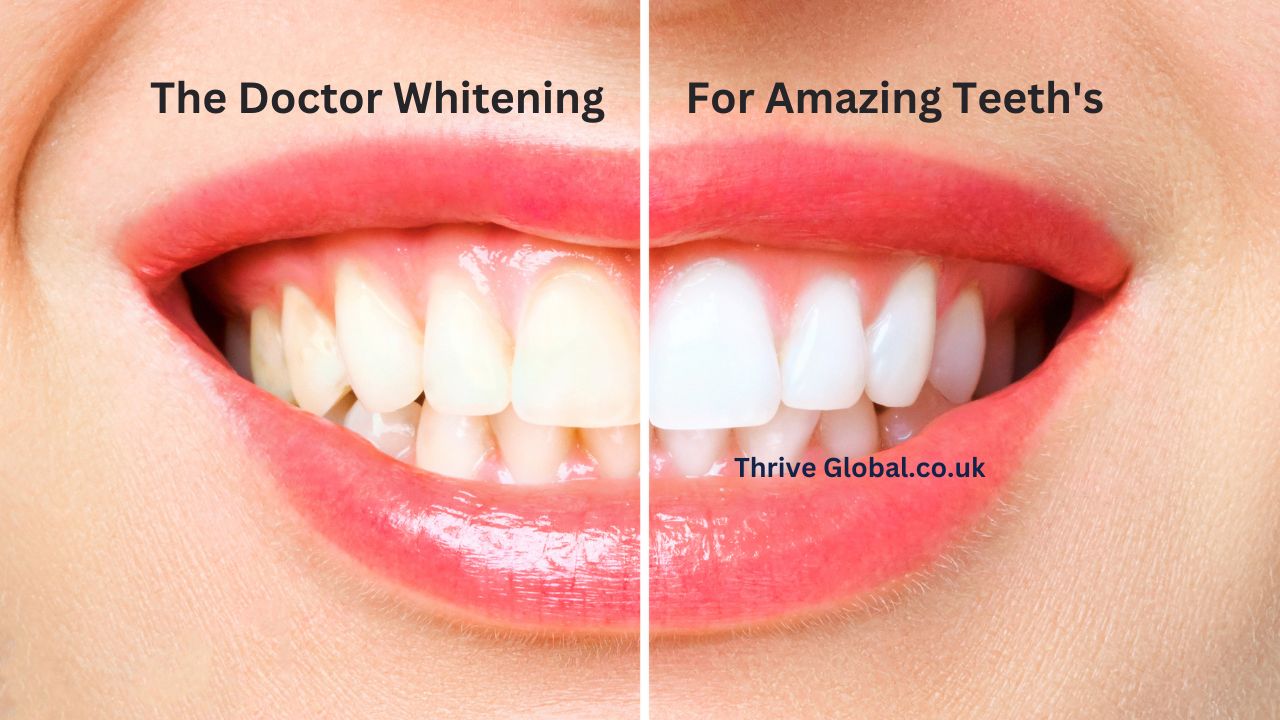Doctor whitening, also known as professional teeth whitening, is a cosmetic dental procedure performed by licensed dentists to achieve a brighter and more aesthetically pleasing smile. Unlike over-the-counter whitening products, which often provide inconsistent results and can sometimes cause significant tooth sensitivity, doctor whitening utilizes advanced techniques and specialized equipment to ensure safe, effective, and long-lasting outcomes.
This process typically begins with a thorough dental examination to assess the health of your teeth and gums, ensuring that the whitening treatment is appropriate for you. Dentists use high-concentration bleaching agents, often containing hydrogen peroxide or carbamide peroxide, which are applied under controlled conditions to maximize efficacy while minimizing potential side effects.
Advantages of Doctor Whitening
One of the key advantages of doctor whitening is the level of customization it offers. Dentists can tailor the treatment to address specific staining patterns and sensitivity issues unique to each patient. Additionally, in-office whitening procedures often employ protective measures, such as the use of dental dams and desensitizing agents, to shield the gums and reduce discomfort. Advanced methods like laser or light-activated whitening further enhance the bleaching process by accelerating the chemical reaction, resulting in quicker and more pronounced results.
The professional oversight and personalized care provided during doctor whitening not only lead to a more radiant smile but also ensure the overall health and integrity of your teeth are maintained. This comprehensive approach, combining scientific expertise and cutting-edge technology, makes doctor whitening the gold standard in achieving a luminous, confident smile.
The Teeth Whitening
What Causes Teeth Discoloration?
Before diving into the whitening process, it’s important to understand why teeth discolor in the first place. Common causes include:
- Diet: Foods and drinks such as coffee, tea, red wine, and certain berries can stain your teeth over time.
- Smoking: Nicotine and tar from tobacco are notorious for yellowing teeth.
- Aging: As we age, the enamel on our teeth wears down, revealing the yellowish dentin underneath.
- Medications: Certain medications can cause tooth discoloration as a side effect.
Types of Teeth Whitening Methods
There are various methods to whiten teeth, ranging from over-the-counter products to professional treatments. The main types include:
- Whitening Toothpastes and Rinses: These products contain mild abrasives and small amounts of peroxide to help remove surface stains.
- Whitening Strips and Gels: These are applied directly to the teeth and can produce noticeable results over a few weeks.
- Tray-Based Whitening Systems: These involve wearing a mouth guard filled with a whitening solution for a specified period.
- In-Office Professional Whitening: This method involves a dentist applying a high-concentration peroxide gel to your teeth for immediate results.
Professional Teeth Whitening
In-Office Whitening Procedures
Professional whitening, often referred to as Doctor Whitening, involves a dentist performing the procedure in a dental office. The process typically includes:
- Preparation: Cleaning the teeth to remove any surface debris.
- Application: Applying a high-concentration peroxide gel to the teeth.
- Activation: Using a special light or laser to activate the whitening gel and enhance its effectiveness.
Benefits of Professional Whitening
Opting for professional whitening has several advantages:
- Immediate Results: Noticeable whitening after just one session.
- Customized Treatment: Tailored to your specific dental needs.
- Safety: Monitored by dental professionals, reducing the risk of complications.
How Does Doctor Whitening Work?
Doctor Whitening typically involves using hydrogen peroxide or carbamide peroxide as the active agents. These agents penetrate the enamel to break down stains at a molecular level, resulting in whiter teeth. The procedure is quick, usually taking about an hour, and the results are immediate.
Doctor Whitening vs. Over-the-Counter Products
Effectiveness Comparison
While over-the-counter products can lighten teeth, they often fall short compared to professional treatments. Doctor Whitening provides more dramatic and longer-lasting results because of the higher concentration of whitening agents used and the expertise of dental professionals.
Safety Considerations
Over-the-counter products can sometimes cause gum irritation or increased sensitivity. Professional treatments are safer as they are administered by trained professionals who take precautions to protect your gums and other oral tissues.
Cost Analysis
Though professional whitening is more expensive upfront, it often proves more cost-effective in the long run due to its lasting results and reduced need for frequent touch-ups. Over-the-counter products may require repeated purchases to maintain results, adding up over time.
The Process of Doctor Whitening
Initial Consultation
The journey to a brighter smile begins with a consultation. During this appointment, the dentist will examine your teeth, discuss your goals, and check for any underlying issues that might affect the whitening process.
Custom Treatment Plan
Based on the examination, a personalized treatment plan is developed. This plan outlines the number of sessions needed and any pre-treatment steps. It ensures that the whitening process is tailored to your specific needs and goals.
The Whitening Procedure
During the procedure:
- Preparation: The teeth are thoroughly cleaned, and protective barriers are applied to the gums to prevent irritation.
- Application: The dentist applies the whitening gel to the teeth.
- Activation: A special light or laser is used to enhance the effectiveness of the whitening gel.
Post-Treatment Care
After the procedure, the dentist provides guidelines to maintain your new smile. These may include avoiding certain foods and drinks that can stain your teeth, using touch-up kits if necessary, and maintaining good oral hygiene practices.
Choosing the Right Dentist for Whitening
Qualifications to Look For
Ensure your dentist is qualified and experienced in teeth whitening. Look for certifications and memberships in dental associations. A well-qualified dentist will have the necessary skills and knowledge to provide safe and effective whitening treatments.
Questions to Ask During Consultation
Prepare questions like:
- What whitening method do you use?
- How long will the results last?
- What are the potential side effects?
- Can you show before-and-after photos of previous patients?
Patient Reviews and Testimonials
Check online reviews and ask for patient testimonials to gauge the dentist’s reputation and patient satisfaction. Positive feedback from previous patients can give you confidence in the dentist’s abilities.
Risks and Side Effects of Teeth Whitening
Common Side Effects
Some common side effects include:
- Tooth Sensitivity: Temporary sensitivity to hot and cold, which usually subsides after a few days.
- Gum Irritation: Minor irritation if the whitening agent comes into contact with gums.
Managing Sensitivity
Use toothpaste designed for sensitive teeth and avoid extremely hot or cold foods and drinks for a few days after treatment. Your dentist may also provide a fluoride treatment to help reduce sensitivity.
When to Seek Medical Advice
If you experience severe pain, prolonged sensitivity, or other unusual symptoms, contact your dentist immediately. These could be signs of an adverse reaction that needs professional attention.
Also Read: Extreme Haircut Blog The Bold and the Buzzed Hair Experiences
Long-Term Maintenance of Whitened Teeth
Daily Oral Hygiene Tips
To maintain your whitened teeth:
- Brush twice a day with fluoride toothpaste.
- Floss daily to remove plaque and food particles.
- Use an antiseptic mouthwash to kill bacteria that can cause staining.
Foods and Drinks to Avoid
Limit consumption of staining substances like coffee, tea, red wine, and tobacco. If you do consume these, rinse your mouth with water afterward to minimize staining.
Regular Dental Check-Ups
Visit your dentist regularly for check-ups and professional cleanings to keep your teeth healthy and bright. Your dentist can also perform periodic touch-ups to maintain the whiteness of your teeth.
Alternative Whitening Options
Natural Whitening Methods
Some natural methods include:
- Baking Soda: Known for its mild abrasive properties that can help remove surface stains.
- Oil Pulling: Swishing coconut oil around in your mouth to remove bacteria and stains.
- Hydrogen Peroxide Rinse: Using diluted hydrogen peroxide as a mouthwash to whiten teeth.
Whitening Toothpaste and Mouthwash
These products can help maintain whitened teeth but are less effective than professional treatments. They contain mild abrasives and low concentrations of whitening agents.
DIY Whitening Kits
Over-the-counter kits can provide moderate results. Ensure you follow instructions carefully to avoid damaging your teeth and gums. Consult your dentist before starting any at-home whitening regimen.
Myths and Facts About Teeth Whitening
Debunking Common Myths
- Myth: Whitening damages enamel. Fact: When done correctly, whitening is safe and does not harm enamel.
- Myth: Whitening works on all teeth. Fact: Whitening is less effective on crowns, veneers, and certain stains.
Scientific Facts to Know
- Whitening agents break down stains through oxidation.
- The concentration of the agent affects the speed and effectiveness of the treatment.
- Professional whitening is safe when monitored by a dentist.
The Science Behind Teeth Whitening
How Whitening Agents Work
Whitening agents penetrate the enamel and dentin, breaking down stains through chemical reactions. Hydrogen peroxide and carbamide peroxide are the most common agents used.
Differences Between Hydrogen Peroxide and Carbamide Peroxide
- Hydrogen Peroxide: Acts faster and is often used in professional treatments.
- Carbamide Peroxide: Slower release, suitable for at-home kits.
Innovations in Teeth Whitening
Latest Technologies and Trends
New advancements include:
- LED Light Therapy: Enhances the effectiveness of whitening gels.
- Laser Whitening: Provides rapid results by activating the whitening agents with laser energy.
- Natural Whitening Products: Focus on using organic and less abrasive ingredients.
Future of Dental Whitening
The future holds promise for even safer, more effective, and faster whitening solutions as technology continues to evolve. Research is ongoing to develop whitening agents that are more effective and cause less sensitivity.
Teeth Whitening for Special Occasions
Preparing for Weddings and Events
Plan your whitening treatment at least a month before your big event to ensure your smile is at its brightest. This allows time for any necessary touch-ups and ensures that any sensitivity has subsided.
Last-Minute Whitening Tips
For quick fixes, use whitening strips or pens, but ensure they are safe and won’t cause excessive sensitivity. Avoid foods and drinks that stain and brush your teeth before your event.
Cost of Doctor Whitening
Factors Influencing Cost
Several factors affect the cost of whitening, including the dentist’s experience, location, and the specific whitening system used. The extent of discoloration and the number of sessions required also play a role.
Insurance and Financing Options
Most cosmetic procedures aren’t covered by insurance, but many dental offices offer financing options to make the treatment affordable. Ask your dentist about payment plans or financing through third-party providers.
Conclusion
A bright, white smile can significantly enhance your appearance and confidence. Doctor Whitening offers a safe, effective, and customized solution to achieve the radiant smile you’ve always wanted. With proper care and maintenance, the results can last for years, making it a worthwhile investment in your overall appearance and self-esteem. Don’t settle for dull teeth when a brighter smile is just a dental visit away.
Also Read: To Hell With Being a Saint Im A Doctor
FAQs
How long does Doctor Whitening last?
Doctor Whitening results can last from one to three years, depending on your oral hygiene and lifestyle habits. Regular touch-ups and avoiding staining foods and drinks can extend the longevity of the results.
Is Doctor Whitening suitable for everyone?
Most people can benefit from Doctor Whitening, but it’s essential to have a dental consultation to ensure it’s appropriate for your specific dental condition. Certain factors, such as existing dental restorations or severe tooth sensitivity, may influence suitability.
Can I whiten my teeth if I have dental restorations?
Whitening treatments do not affect crowns, veneers, or fillings. Consult your dentist for alternative options if you have extensive dental work, as they can recommend treatments that harmonize the color of natural teeth and restorations.
How can I maintain my whitened teeth for the longest time?
Maintain good oral hygiene, avoid staining foods and drinks, and visit your dentist regularly for touch-ups and professional cleanings. Using whitening toothpaste and mouthwash can also help maintain the brightness of your teeth.
Are there any foods or drinks that help in maintaining whitened teeth?
Foods like apples, celery, and carrots can help clean your teeth naturally. Drinking water after meals can also help reduce staining. Additionally, consuming dairy products can strengthen enamel and keep your teeth looking bright.









